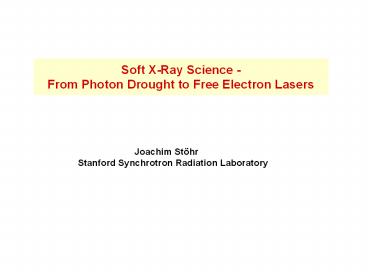Joachim%20St - PowerPoint PPT Presentation
Title:
Joachim%20St
Description:
Joachim Sthr – PowerPoint PPT presentation
Number of Views:44
Avg rating:3.0/5.0
Title: Joachim%20St
1
Soft X-Ray Science - From Photon Drought to Free
Electron Lasers
Joachim Stöhr Stanford Synchrotron Radiation
Laboratory
2
What are Soft X-Rays ?
Soft X-Rays
VUV
Hard X-Rays
100 eV 10 nm
1000 eV 1 nm
30 eV
3000 eV
Large angle optics
grazing incidence optics
air
vacuum
3
Closing the Soft X-ray Gap gt 285 eV 1975 - 77
Stanford 1977
Hamburg 1976
Flipper monochromator
Grasshopper monochromator
SEXAFS Oxidized Al 12/ 5/1977
500 eV
800 eV
4
Why are Soft X-Rays so Useful?
- 1. X-ray absorption cross section is large
sensitive to small atoms - surface science, interfaces, thin films,
nanostructures - 2. Lifetime width is narrow spectroscopy of
electronic structure - valence states information through
core-to-valence transitions - 3. Spectral range contains important absorption
edges (elements) - C, N, O chemistry/biology Fe, Co, Ni
magnetism - 4. Large resonance effects and polarization
effects dichroism - NEXAFS - charge magnetic dichroism spin /
orbital moments - Wavelength is of nanometer scale (4 1 nm)
nanoscale imaging - real space imaging lenses reciprocal space
imaging - lensless
5
Tunable soft x- rays offer large interaction
cross sections
electrons
optical light
Photoemission
neutrons
6
Spectroscopy 1980s 1990s
7
Tunable soft x-rays offer elemental specificity
Transitions provide information on valence charge
and spin
8
Tunable x-rays offer chemical specificity
9
Rich multiplet structure reveals local bonding
10
Polarized x-rays offer orientation sensitivity
Antiferromagnetic order
Orientational order
Directional Chirality
Ferromagnetic order
11
Magnetic Circular Dichroism
12
Spectro Microscopy 1990s
13
Nanoscale Devices in Computers
14
Focusing of x-rays offers nanoscale
resolution
15
Polarization Dependent Imaging with X-Rays
16
Coupling of ferromagnetic and antiferromagnetic
domains
Co edge use circular polarization
ferromagnetic domains
Ni edge use linear polarization
antiferromagnetic domains
H. Ohldag et al., PRL 86, 2878 (2001)
17
Images of the Ferromagnet-Antiferromagnet
Interface
Ohldag et al., PRL 87, 247201 (2001)
18
Lensless Imaging - Scattering
2000s
19
Fe L-edges
Kortright and Kim, Phys. Rev. B 62, 12216 (2000)
20
Lensless imaging by scattering
But can one solve the phase problem and invert
the image?
21
Development of coherent imaging with low
intensity synchrotron radiation
soft x-ray spectro holography
coherent x-ray beam
Eisebitt, Lüning, Schlotter, Lörgen, Hellwig,
Eberhardt and Stöhr, Nature 432, 885 (2004)
22
Nanoscale Dynamics
23
The Technology Problem Smaller and Faster
The ultrafast technology gap want to
reliably switch small magnetic bits
X-rays combine nanometer spatial with picosecond
time resolution
seeing the ultrafast nanoworld
24
Spin currents a new way of magnetic switching
new idea torque on by spin
current
traditional switching torque on by
Oersted field
sensor layer
current
current
referencelayer
sensor layer
Weak, long range
Strong, short range
25
Scanning Transmission X-Ray Microscopy image of
spin injection structure
100 x 300 nm
2 nm magnetic layer buried in 250nm of metals
100 nm
current
leads for current pulses
Detector
Y. Acremann et al., Phys. Rev. Lett. 96, 217202
(2006)
26
Soft x-rays at their best..
- Sensitivity to buried thin layer (2nm)
- Cross section just right - can see signal
from thin layer - X-rays can distinguish layers, tune
energy to Fe, Co, Ni, Cu - Resolving nanoscale details (lt 100 nm)
- Spatial resolution, x-ray spot size 30
nm - Magnetic contrast
- Polarized x-rays provide magnetic contrast
(XMCD) - Sub-nanosecond timing
- Synchronize spin current pulses with 100 ps
x-ray pulses
27
Sample 100nm x 200nm, 2nm CoFe free layer
current pulse
switch
switch back
Switching best described by movement of vortex
across the sample!
28
The Future
29
From the past into the future
Peak brightness
Average brightness
Information density
30
Summary
- Soft x-rays offer complementary capabilities to
hard x-rays - Spectroscopic studies reveal atom-projected
- charge and spin properties of valence
electrons - Microscopic studies reveal charge and spin
distributions on nanoscale - Time dependent studies reveal nanoscale dynamics
down to tens of picoseconds - The future femtosecond snapshots ????































![[pdf] read free the death of joachim murat: 1815 and the unf PowerPoint PPT Presentation](https://s3.amazonaws.com/images.powershow.com/10141185.th0.jpg?_=202409270412)